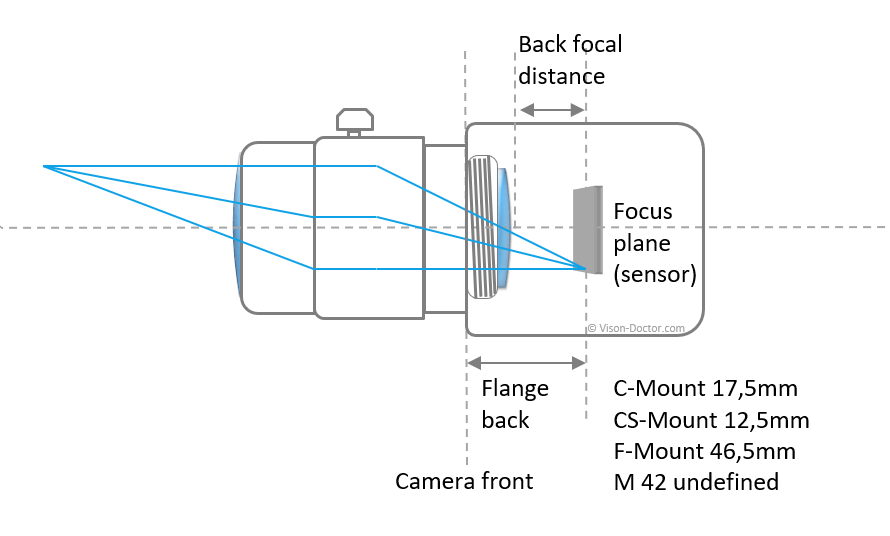Lens mount, flange focal length and back focal length
Machine vision cameras mainly use the C-mount connection to mount the lenses. In case of the very compact "sugar cube" cameras, you can also find CS-mount connections in order to have a larger installation space for the camera electronics. CS-mount is the prevailing standard for monitoring cameras. The exact flange focal length for C-mount is 17.526 mm (= 0.6900").
 |
The C-Mount connection is an inch thread, known by the specification 1-32UN-2A. It has a 1 inch outside diameter, 32 TPI (threads per inch = 32 threads per inch, 0.784 mm per thread) and a 60° flank angle. It is roughly equivalent to the M25.4 x 0.8 mm metric thread with 60°.
The connection standard is historically influenced by the beginnings of American film technology and has survived to this day in video technology and image processing. The C-mount thread was standardized by the Society of Motion Picture and Television Engineers (abbreviated: SMPTE) and the American National Standards Institute (abbreviated: ANSI).
The C-mount thread has a flange focal distance of 17.526 mm, while the CS-mount has only 12.5 mm. It has a shorter flange focal distance and therefore a shorter design. All other dimensions and diameters are the same as for the C-mount thread.
By using a C-CS-mount adapter, each CS-mount camera can be used with practically any C-mount lenses (provided that the thread is not too long so that it cannot be screwed into a 5mm ring completely). The use of CS-mount lenses on C-mount cameras is not possible. Due to their short flange focal length, CS-mount lenses are ideal to design inexpensive extreme wide-angle lenses. This is especially important in monitoring technology.
The F-mount connection refers to the bayonet system by Nikon which has already been developed in the late 1950s. The flange focal length is 46.5 mm. The F-mount, like the M42 screw thread, is mainly required for high-tech cameras with particularly large sensors which provide an especially high resolution with large pixels. This applies to industrial area scan and line scan cameras. Depending on the manufacturer, different flange focal distances used to be common for M42, e.g. 45.46 mm or 45.5 mm. However, this does not matter for industrial cameras, available lenses are adapted to the cameras with matching tubes, which do not provide the required flange focal distance with their compact housings anyway. Important to know: There are two different types in use for the M42 mount. The T2 connection has a 42mm thread with a pitch of 0.75 mm. This must not be confused with the T1 camera connection M42x1 mm. The threads are not compatible! In this way the sensor can be mounted very close to the camera housing, which allows for a more compact design of the camera. However, the required distance between optics and sensor must be created by means of lens barrels.
Back focal length of lenses
From their measures, lenses do rarely end at the contact surface of the camera, but their last lens group usually sticks into the camera housing. The back focal length refers to the measure from the vertex of the last lens to the imaging array. This can be observed very often particularly in case of wide-angle lenses.
Lens mounting problems:
There are often problems with the back focal length when using CS-mount cameras with C-mount adapter + wide-angle C-mount lens. Some lenses touch the inner edge of the C-mount adapter in certain focusing positions.
Three-CCD/ CMOS cameras with a multi-part prism in front of the sensors, too, do not permit that the optics stick into the interior of the camera. Special three-board lenses typically provide a special colour correction and avoid this problem by means of a different lens design. Of course they can also be used as "normal optics" with low back focal length at any time.







